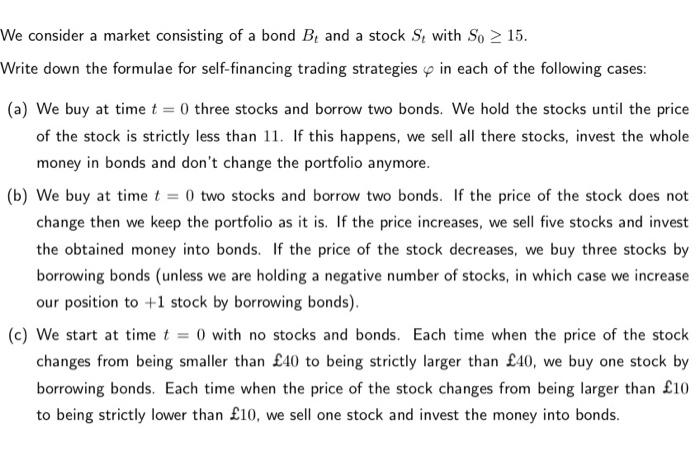We consider a market consisting of a bond B, and a stock S, with So > 15. Write down the formulae for self-financing trading strategies o in each of the following cases: (a) We buy at time t = 0 three stocks and borrow two bonds. We hold the stocks until the price of the stock is strictly less than 11. If this happens, we sell all there stocks, invest the whole money in bonds and don't change the portfolio anymore. (b) We buy at time t = 0 two stocks and borrow two bonds. If the price of the stock does not change then we keep the portfolio as it is. If the price increases, we sell five stocks and invest the obtained money into bonds. If the price of the stock decreases, we buy three stocks by borrowing bonds (unless we are holding a negative number of stocks, in which case we increase our position to +1 stock by borrowing bonds) (c) We start at time t = 0 with no stocks and bonds. Each time when the price of the stock changes from being smaller than 40 to being strictly larger than 40, we buy one stock by borrowing bonds. Each time when the price of the stock changes from being larger than 10 to being strictly lower than 10, we sell one stock and invest the money into bonds. We consider a market consisting of a bond B, and a stock S, with So > 15. Write down the formulae for self-financing trading strategies o in each of the following cases: (a) We buy at time t = 0 three stocks and borrow two bonds. We hold the stocks until the price of the stock is strictly less than 11. If this happens, we sell all there stocks, invest the whole money in bonds and don't change the portfolio anymore. (b) We buy at time t = 0 two stocks and borrow two bonds. If the price of the stock does not change then we keep the portfolio as it is. If the price increases, we sell five stocks and invest the obtained money into bonds. If the price of the stock decreases, we buy three stocks by borrowing bonds (unless we are holding a negative number of stocks, in which case we increase our position to +1 stock by borrowing bonds) (c) We start at time t = 0 with no stocks and bonds. Each time when the price of the stock changes from being smaller than 40 to being strictly larger than 40, we buy one stock by borrowing bonds. Each time when the price of the stock changes from being larger than 10 to being strictly lower than 10, we sell one stock and invest the money into bonds







